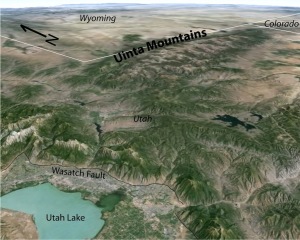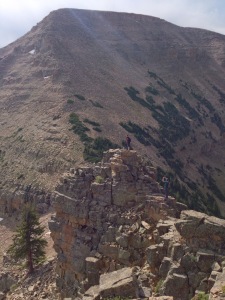The Uinta Mountains are a large east-west trending mountain range (on of the few in North and South America). It is made of a 4-km thick Neoproterozoic siciliclastic succession. These strikingly monotonous sediments are hypothesized to record the development of a large E-W trending intracratonic basin during the early stages of the breakup of Rodinia. Subsequent to deposition, the Uinta Mountains were formed as the Neoproterozoic basin inverted during the Laramide orogeny. It is thought that the pre-existing weakness formed during the rifting of Rodinia allowed for basin inversion despite the long axis of the basin being parallel to the maximum stress.
 |
| from Google Earth |
| Detrital zircons from the Uinta Mountain Group reveal that the bulk of these sediments were derived at least 1000 km away from the Grenville highlands that would have extended along the eastern margin of Laurentia from Texas to Labrador (Dehler et al., 2010 GSA Bull). Additionally the youngest zircons of ~760 Ma constrain the Neoproterozoic maximum depositional age. |
| During the last glacial maximum the Uinta Mountains were sculpted by valley glaciers that created a single narrow spine with dozens of long, thin ridges extending north and south of the main ridge. Glaciations has created the highest mountains in Utah and has 16 peaks over 13k feet. |
 |
| Left foreground: Reids Peak (11,708 ft) with Dana, center distance: Hayden Peak (12,479 ft), right: Bald Mountain (11,947 ft) |
 |
| Massive cirque leading out towards the southwest. |
![]() This work is licensed under a Creative Commons Attribution-NonCommercial-ShareAlike 4.0 International License.
This work is licensed under a Creative Commons Attribution-NonCommercial-ShareAlike 4.0 International License.


